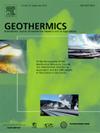射流冲击下高温非均质岩石的热耦合FSI分析
IF 3.5
2区 工程技术
Q3 ENERGY & FUELS
引用次数: 0
摘要
射流冲击是地质资源开发中一种有效的破岩方法。在高温地层中,温差引起的热应力与流体压力和冲击力相互作用,进一步提高了岩石破坏的效率。同时,岩石本身的非均质性也影响着岩石的应力分布和破坏特征。为了解释这一复杂的过程,本文建立了一个多物理场耦合模型,采用有限离散元法(FDEM)和威布尔分布来描述岩石的力学响应和非均质性。计算了温度、应力和裂纹扩展的演化过程,揭示了不同地层条件和射流参数下岩石的破坏机制。研究结果表明,射流压力的增加显著提高了射流速度,提高了换热效率,改变了热传导向对流换热的转变。因此,产生了更大的热应力,并伴随着岩石表面喷射压力的增加。这两个因素的综合作用导致裂纹长度开始减小,随后增加。虽然岩石温度对射流速度的影响较小,但由于温差的变化,在温度升高时传热效率也有所提高。相应的,热应力和裂纹长度不断增大。此外,非均质性的增强加剧了岩石的损伤。在本研究中,当岩石温度总体超过200℃时,热应力对裂纹长度的影响较为明显。然而,岩石非均质性的提高降低了裂纹扩展的临界温度阈值。研究结果为深入了解多物理场耦合影响下的岩石破坏机制提供了依据。本文章由计算机程序翻译,如有差异,请以英文原文为准。
Thermo-coupled FSI analysis of high-temperature heterogeneity rocks subjected to jet impingement
Jet impingement is an efficient rock breaking method in the development of geological resources. In high-temperature formations, thermal stress induced by the temperature difference interacts with fluid pressure and impact forces, thus further enhancing the efficiency of rock failure. Meanwhile, the inherent heterogeneity of rocks influences stress distribution and failure characteristics of rocks as well. To elucidate this intricate process, a multi-physics coupling model is developed in the present study, in which the finite-discrete-element method (FDEM) and Weibull distribution are employed to describe the mechanical response and heterogeneity of rocks. The evolution of temperature, stress, and crack propagation are computed to reveal rock failure mechanisms under different formation conditions and jet parameters. The findings indicate that increasing jet pressure markedly increases jet velocity, improves heat transfer efficiency, and changes the transition from heat conduction to convective heat transfer. Thereby, greater thermal stress is induced, which is accompanied by the application of increased jet pressure on the rock surface. The combined effects of these two factors result in an initial decrease followed by a subsequent increase in crack length. Although rock temperature has fewer effects on jet velocity, the heat transfer efficiency also increases at elevated temperatures resulting from the variation of temperature differences. Correspondingly, thermal stress and crack length rise continually. Moreover, heightened heterogeneity exacerbates rock damage. In this research, thermal stress exerts pronounced effects on crack length once rock temperature exceeds 200 °C on the whole. However, the heightened rock heterogeneity can lower the critical temperature threshold for the propagation of cracks. The results of this investigation provide an in-depth insight into the rock failure mechanism influenced by multi-physics coupling.
求助全文
通过发布文献求助,成功后即可免费获取论文全文。
去求助
来源期刊

Geothermics
工程技术-地球科学综合
CiteScore
7.70
自引率
15.40%
发文量
237
审稿时长
4.5 months
期刊介绍:
Geothermics is an international journal devoted to the research and development of geothermal energy. The International Board of Editors of Geothermics, which comprises specialists in the various aspects of geothermal resources, exploration and development, guarantees the balanced, comprehensive view of scientific and technological developments in this promising energy field.
It promulgates the state of the art and science of geothermal energy, its exploration and exploitation through a regular exchange of information from all parts of the world. The journal publishes articles dealing with the theory, exploration techniques and all aspects of the utilization of geothermal resources. Geothermics serves as the scientific house, or exchange medium, through which the growing community of geothermal specialists can provide and receive information.
 求助内容:
求助内容: 应助结果提醒方式:
应助结果提醒方式:


